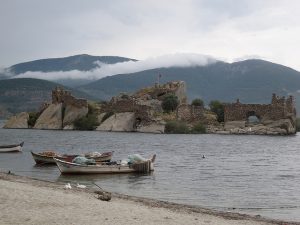 In bucolic but earthquake-prone Armenia, people both fear and rely on a nuclear power plant that has operated for three decades with no primary containment structure.
In bucolic but earthquake-prone Armenia, people both fear and rely on a nuclear power plant that has operated for three decades with no primary containment structure.
In the 1970s, a series of first-generation nuclear reactors were built in the former Soviet Union, all lacking the infrastructure to contain major ruptures in the reactor’s primary circuit. Should a large rupture occur and the facility begin to overheat, the reactor would open to the outside air to cool down, exposing the surrounding environment to its contents and whatever accidents subsequently befell them.
One such nuclear power plant was built in present-day Armenia, in one of the most seismically active areas on the planet, a recent National Geographic article reports. Concerned citizens, scientists and international agencies have called on the Armenian government to shut down the plant, but there’s a snag: The plant supplies more than 40 percent of the power in a country that is exceptionally hard-pressed for energy.
The 31-year-old Metsamor power station is one of just five first-generation VVER 440 nuclear plants that lacks a primary containment structure. The rest are in Russia. The Armenian government has started planning to replace Metsamor’s 750 MW of capacity by 2016, but many are worried about what may happen in the intervening five years.
One-third of Armenia’s population live just 20 miles away, in the capital city of Yerevan. At a time when many countries in the Middle East are charging ahead with plans to develop nuclear power, including Armenia’s neighbor to the west, Turkey, Armenians dread becoming a tragic illustration of the dangers of nuclear technology.
At the same time, however, Armenians, are loath to turn off the plant until an equally large power generator has replaced it. Armenia was cut off by both of its nearest neighbors, Azerbaijan and Turkey, after the dissolution of the Soviet Union, so it relies on fuel imports from more distant countries, mainly Russia. After a 6.8-magnitude earthquake hit Armenia in 1988, the plant was shut down for six years even though it had escaped any damage. Ara Tadevosyan, director of a major Armenian news agency, recalled these years as a time of extreme deprivation in National Geographic:
“There were severe power shortages during the winter months. We had a situation where you had one hour of power a day, and sometimes no power at all for a week. You can imagine—it was as cold in the apartment as it was in the street.”
More than a thousand safety improvements have been made to the plant since it restarted in 1995, but that didn’t stop a United Nations envoy from calling the plant a “danger to the entire region” in 2004, or the United States from underwriting a study that similarly urged the country to replace it.
The European Union required Bulgaria and Slovakia to shut down VVER 440 units in those countries before they could join the EU. Since the EU hasn’t been able to convince Armenia to do the same, it has instead spent more than 59 million euros trying to improve the safety and sustainability of Armenia’s power supply.
Next year, Armenia plans to begin work on a new, $5 billion VVER 1000 nuclear reactor project: first steps toward its emancipation from the aging VVER 440. But that project won’t help relieve Armenia’s dependence on volatile, foreign sources of energy. As Green Prophet recently reported, a huge amount of oil is necessary to extract uranium, the fuel needed to run nuclear power plants.
For true peace of mind, Armenia should seek cleaner, more sustainable sources of energy within its own borders.
Read more about nuclear power in the Middle East:
Despite Japan, Turkey Goes Ahead With Nuclear Reactors
Time to Pause: Risks of Nuclear in the Volatile Middle East and North Africa Region
Nuclear Power Continues World Dependence on Middle East Oil
Image via Chuckdad



